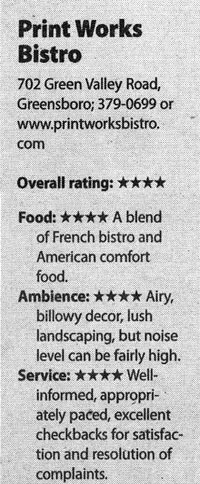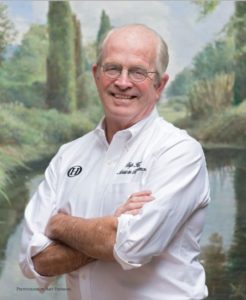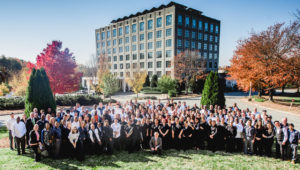A Green Hotel Leaves a Sustainable Legacy
A hotel exec in North Carolina finds that investing in solar and energy efficiency makes good business sense.
A hotel exec in North Carolina finds that investing in solar and energy efficiency makes good business sense.

The Proximity Hotel in Greensboro, North Carolina, is the country’s first hotel to achieve LEED platinum status – the Green Building Council’s highest certification. And that wasn’t even the goal!
Quaintance: “The only ambition was, let’s sincerely consider sustainable practices with each of our decisions.”
That’s Dennis Quaintance, CEO of Quaintance-Weaver Restaurants and Hotels. After his children were born, he and his wife considered the legacy they would leave behind and committed to running a sustainable as well as financially sound company. To do so, they used a single question to guide all major decisions.
Quaintance: “Is there a sustainable angle that’s practical?”
This led to the construction of a hotel with rooftop solar panels to heat water, ultra-efficient appliances to reduce energy use, and elevators that actually generate power. Many of these choices were more expensive than traditional options. But as a result, the Proximity uses almost 40 percent less energy than other hotels its size.
Within only four years, the extra costs paid for themselves in energy savings and tax credits. So the result is a hotel that’s both sustainable and profitable.
Reporting credit: Sarah Kennedy/ChavoBart Digital Media.
AUTHOR
Justin Catanoso is a professor of journalism at Wake Forest University in Winston-Salem, North Carolina, who specializes in covering climate change internationally.
The leaders of the Quaintance-Weaver restaurant group have been nominated for a James Beard Foundation award.
Dennis and Nancy Quaintance, along with Mike Weaver, of Quaintance-Weaver Restaurants in Greensboro, are among the national semifinalists in the 2009 Restaurant and Chef awards. They are in the running for the Outstanding Restaurateur award.
“I couldn’t believe it,” Dennis Quaintance said. “I never conceived it.”
Quaintance-Weaver – which leads the restaurant teams of Lucky 32, Green Valley Grill and Print Works Bistro – is one of 20 national semifinalists with only two being from the southeast. It was chosen from a list of 15,000 nominations in 19 categories.
The James Beard Foundation Awards are compared to the Oscars of the food world.
Quaintance credits the nomination to the efforts of his restaurants to be locally sustaining, the purity and quality of the food and perhaps recent advances in being more green. He also gives unabashed credence to his restaurants’ staffs.
“What I feel like doing is walking out and hugging a bunch of people in our restaurants,” he said. “They are the ones humping it everyday. This would have never happened were it not for their collective behaviors and sincerity.”
The finalists will be announced March 23 at ceremony in Chicago.
MORE
What is Outstanding Restaurateur?
A working restaurateur who sets high national standards in restaurant operations and entrepreneurship. Candidates must have been in the restaurant business for at least 10 years. Candidates must not have been nominated for a James Beard Foundation chef award in the past 10 years.
Nominee Selection and Judging
Anyone can submit a chef or restaurant for consideration during the online open call for entries in the fall. Entries are tabulated by the independent accounting firm Lutz & Carr, and based on the results, the Restaurant and Chef Awards Committee produces a nominating ballot with up to 20 semifinalists in each category. This ballot is distributed online to more than 400 judges, who select the five official nominees in each category. The same judges then vote on these five nominees to choose the winners.
The judges include previous Restaurant and Chef Award winners, the Restaurant and Chef Awards Committee, 25 leading regional restaurant critics, food and wine editors, and culinary educators in each of the 10 regions. There are more than 400 judges nationwide.
In each category, the judges are looking for individuals whose contribution to their field is unique and long-lasting.
(4 Star Review)
By John Batchelor | Go Triad
Published: July 12, 2012
 GREENSBORO — Print Works Bistro is the restaurant of Proximity Hotel, a Quaintance-Weaver property. Both the hotel and restaurant have been recognized as the “greenest” such establishments in America, certified LEED Platinum.
GREENSBORO — Print Works Bistro is the restaurant of Proximity Hotel, a Quaintance-Weaver property. Both the hotel and restaurant have been recognized as the “greenest” such establishments in America, certified LEED Platinum.
Lush landscaping with streamside outdoor seating and airy interior decor create casual sophistication. The look is bright and billowy, a function of tall windows plus cream-colored floor to ceiling drapes hung throughout, sectioning off various dining areas. Noise level can be fairly high. Live music in the bar on Wednesday nights permeates dining areas all the way to the back wall, where yelling in the kitchen is also evident. The impact is not harsh; draperies soften the edge somewhat.
Cuisine loosely follows a French bistro concept, combined with contemporary American comfort food — variations on the familiar, but never boring. Ingredients from nearby farms and producers are central to the concept. Execution is precise and consistent.
The crust in flatbread is firm and flavorful in its own right. In the Duck Confit version, tender duck benefits from sweet, soft shredded shallots, soaked in sugar and white balsamic vinegar, plus mellow cheese — a cross between feta and mozzarella — from Chapel Hill Creamery. A hot iron bowl hosts Onion Soup, the flavorful veal broth enriched with abundant soft-cooked onions and aged Ementhaler cheese.
A cheeseburger is about a half-inch thick, generating very good, natural beef flavor. The meat is local, from Bobby Brad’s Family Farm. The egg-based challah bun is imported from Tribeca Bakery in New York. It comes with fries. This would have been included in my recent “best burgers” list had it not duplicated the entry from Green Valley Grill, Print Works’ corporate sibling.
A mixed green salad of leaf lettuces hosts green beans, sliced carrots and radishes, chopped celery and clipped green onions, accented by a very light, creamy herb dressing.
In Steak Frites, Certified Angus Beef hanger steak is seasoned with herbed butter. The meat is surprisingly tender, a function of how it is sliced — diagonally across the grain. Crisp fries are cut in-house, skin on, about ¼-inch thick, yielding very good potato flavor. A few uncooked spinach leaves provide a weak excuse for a green vegetable.
Other entrees came with mashed potatoes blended with crème fraiche, joined by French-style green beans — with the protein, adding up to a complete meal.
Te nder Trout filet delivers delightfully mild flavor, well-served by a light coating of herbed bread crumbs drizzled with lemon caper beurre blanc sauce.
nder Trout filet delivers delightfully mild flavor, well-served by a light coating of herbed bread crumbs drizzled with lemon caper beurre blanc sauce.
Black Pepper Grilled Salmon exudes unusually good salmon flavor, enhanced with honey lime butter sauce. The fish is sustainably raised by Marine Harvest in Canada.
An off-menu special of Corvina, a white-fleshed fish of the drum family, had been baked en papillotte with clams, sealing in moisture while infusing the fish with clam flavor.
Certified Angus Beef Short Ribs are falling-off-the-bone tender, the deep flavor of the meat enhanced by caramelized spring onions, creating a luscious extension.
Desserts are a particular treat. Profiteroles — puff pastry balls — are filled with homemade vanilla ice cream. Servers ladle hot chocolate sauce tableside to wonderful effect.
In Champagne and Berry Gelee, the gel holds berries, their flavor augmented by crème anglaise and homemade macaroons.
These experiences validate the overall impression that Print Works continues to rank as one of the Triad’s best restaurants. Although I did not encounter any problems during these review visits, I am aware from numerous prior experiences that Quaintance-Weaver establishments are among the best for resolving a complaint.
John Batchelor has been reviewing restaurants for 30 years. His reviews run on the second and fourth Thursday of the month. Contact him at john.e.batchelor@gmail.com.
By Jerri Rowe
News & Record, June 2014 | Listen to the song!
It’s a cowboy song for GSO. And it fits.
Jessica Mashburn and Evan Olson– better known as the duo AM rOdeO– wrote it to celebrate the 25th anniversary last week of Lucky 32 Southern Kitchen, the upscale joint off Westover Terrace with the great fried chicken.
But really, the song celebrates the drifter from Missoula who rolled into town long before e-mail.
Well, that’s what the song says.
Click on it below and Check it out it for yourself.
It’s a tune about Dennis Quaintance.
You know, he’s the spunky idealist from Montana who came to GSO in 1978. He came into the city wearing cowboy boots and a sports jacket with leather patches to work at Franklin’s Off Friendly restaurant across from Guilford College.
He married a local girl named Nancy, a Cornell grad who worked at Franklin’s, and they ended up raising twins and becoming, as Dennis likes to say, “Mr. and Mrs. Hotel-Restaurant – Greensboro.’’
Nancy and Dennis helped create behind Lucky 32 as well as Green Valley Grill, O Henry Hotel, Printworks Bistro and Proximity Hotel.
And Dennis helped make Proximity the greenest hotel east of San Francisco by putting in a roof full of solar panels and creating North Carolina’s largest solar hot-water system.
Four years ago,Outside magazine called the Proximity one of the country’s top ecotravel getaways. Yeah, I call the Proximity the hybrid car of hotels.
But what began it all for Mr. and mrs. Hotel-Restaurant-Greensboro was Lucky 32. It was named after Dennis’ father, Laythol.
I know. Huh?
Well, Laythol — L.W. or Shorty — raced a ’46 Mercury with a flathead V8 on half-mile dirt track around northern Iowa and southern Minnesota. His car’s number? 32. And Dennis says when something good happens, he mutters “Lucky 32.’’
He also says “golly.” A lot. At least to me.
Anyway, Dennis likes music by Marty Robbins and Gene Autry. Jessica knows that. She does music programming for Dennis and Nancy and their businesses. And both Jessica and Evan had worked for them over the years.
Evan waited tables at Lucky 32 during his days 20 years ago traveling with the band Bus Stop up and down the East Coast and becoming almost famous.Bus Stop, a regional favorite, got so close to going bigtime.
Meanwhile, Jessica worked first as a server at Green Valley Grille and the Lucky 32 in north Raleigh as well as an event manager at O Henry. And today, Jessica and Evan play every Wednesday night at Print Works Bistro as AM ROdeO.
So, they know Dennis. They know Nancy. And with the 25th anniversary coming up, the two figured they’d give them a gift.
How? With a song.
They got the idea when they read the Lucky 32 newsletter and the comments from Dennis. Yeah, those comments were long. Then, they sat down at their house and got busy. Jessica and Evan wrote the lyrics, Evan wrote the music, and before last Thursday’s 25th anniversary celebration at Lucky 32, they recorded the tune in their home studio and e-mailed Dennis the tune.
Still why do all that? Says Jessica:
“He didn’t ask us to do it. But we saw it as our way of giving him a gift. People who paint give people paintings or things they have created, and since we’re musicians, we think of giving music as gifts.’’
The tune,“25 Years & Counting’’ was played over the sound system at last Thursday’s two celebrations at Lucky 32. And now, it’s permanently on the restaurant’s playlist.
Eat there anytime. You’ll hear it.
It’s a fun tune. Hummable, too. And love that twangy country guitar. But really, if you know Dennis, it fits. Check out the lyrics in the upper right box.
I read the lyrics. I listened to the tune. And I wondered.
What does Dennis think?
Jessica told me. She got an e-mail from Dennis right away.
Classic Dennis.
“You and Evan,’’ he wrote, “can push me over a feather.’’
AAA GO MAGAZINE- July/August 2016
Proximity Hotel
Greensboro, NC
By: Tiffany Wright
 Recognized by many as the “greenest” hotel in America, Proximity Hotel leaves other properties green with envy thanks to its innovative design, which gives guests a sneak peek into the future, while honoring the rich history of Greensboro, N.C.
Recognized by many as the “greenest” hotel in America, Proximity Hotel leaves other properties green with envy thanks to its innovative design, which gives guests a sneak peek into the future, while honoring the rich history of Greensboro, N.C.
The AAA Four Diamond hotel was the first property to ever be certified LEED Platinum, meaning its construction, operation and design make it the highest performing “green” building. The 147-room property uses 40 percent less energy and 30 percent less water than a conventional hotel.
Proximity’s commitment to saving energy is evident throughout the entire property during guests’ stay. Oversized windows in the contemporary style guest rooms offer natural light and fresh air, and guests enjoy their showers in hot water generated from the 100 solar panels on the roof.
The hotel even offers free loaner bicycles, which allow guests to explore the lunch greenery surrounding the property. Visitors can enjoy the outdoor terrace with a flower garden nestled alongside a stream. Other amenities include an outdoor pool and a 24-hour complimentary fitness center.
Proximity’s restaurant, Print Works Bistro has consistently been named one of Greensboro’s top restaurant. Diners rave about the weekend brunch featuring the signature PWB Benedict and popular duck confit hash.
Sustainable practices can still be found while dining, the bistro’s bar is created from reclaimed walnut trees and room service trays are made of Plyboo (bamboo plywood).
Located less than 10 miles fro Piedmont Triad International Airport, Proximity Hotel’s energy saving measures attract visitors from across the country. The unique and cutting edge property promotes conservation while spoiling guests with all the luxuries of a boutique hotel.
The ubiquitous, serendipitous life and art of Chip Holton
by: Nancy Oakley, O.Henry Magazine December 2016
 Chip Holton breezes down a central hallway of the O.Henry Hotel, clad in a simple black T-shirt and jeans, greeting the hotel staff with affable “heys” and “hellos” as he makes his way to the Green Valley Grill before it opens for lunch. Pointing to the arched space, or lunette, above the kitchen, the artist explains that the mural occupying it — a massive table laden with a feast of chicken, ham, fish, a loaf of bread, fruits, melon and wine — was meant to effect the Old World ambiance that hotelier Dennis Quaintance hoped for. “I’ve been working for Dennis for twenty-plus years,” says Chip, who insists that everyone call him by his first name, certainly not “Mr. Holton,” let alone “Frank P. III.” He and Quaintance met when the hotel’s designer, the late Don Rives, (“one of my best buddies,”
Chip Holton breezes down a central hallway of the O.Henry Hotel, clad in a simple black T-shirt and jeans, greeting the hotel staff with affable “heys” and “hellos” as he makes his way to the Green Valley Grill before it opens for lunch. Pointing to the arched space, or lunette, above the kitchen, the artist explains that the mural occupying it — a massive table laden with a feast of chicken, ham, fish, a loaf of bread, fruits, melon and wine — was meant to effect the Old World ambiance that hotelier Dennis Quaintance hoped for. “I’ve been working for Dennis for twenty-plus years,” says Chip, who insists that everyone call him by his first name, certainly not “Mr. Holton,” let alone “Frank P. III.” He and Quaintance met when the hotel’s designer, the late Don Rives, (“one of my best buddies,”
“I’ve been working for Dennis for twenty-plus years,” says Chip, who insists that everyone call him by his first name, certainly not “Mr. Holton,” let alone “Frank P. III.” He and Quaintance met when the hotel’s designer, the late Don Rives, (“one of my best buddies,” Chip describes him . . . as nearly everyone he encounters seems to be) recommended to Quaintance that Chip paint a mural for Lucky 32 Restaurant. “Serendipity is part of what I do,” Chip observes. “A lot of work comes to me that way.” Whether helping out a friend, which landed him a gig as set designer for Twin City Stage in Winston-Salem, or striking up a conversation with Dave Fox at Thursday night Cocktails and Jazz and agreeing to give a visual interpretation to a “musical tapestry” the musician is composing. Chip describes his relationship with Quaintance as “brotherly,” unusual for a boss and employee, or patron and artist, if you will. “He’s sort of my Pope Julius,” the artist says of his employer, referring to Julius II, who commissioned
Chip describes his relationship with Quaintance as “brotherly,” unusual for a boss and employee, or patron and artist, if you will. “He’s sort of my Pope Julius,” the artist says of his employer, referring to Julius II, who commissioned Michelangelo’s painting of the Sistine Chapel. “I kid him about it. But he’s a
jolly pope. Nobody that would put you in chains in the Vatican if you misbehaved.” In time, with his exceptionally broad range of skills and artistic styles, Chip became vital to the aesthetic of both the O.Henry and Proximity Hotel, where he was given the title, artist-in-residence.
He painted the semirecumbent portrait of William Sydney Porter in the lobby of the O.Henry. Taken from a photograph he and Rives discovered at the Greensboro Historical Museum, “part of the picture didn’t exist,” Chip recalls. “So I had to have somebody pose in a jacket in the chair and invented the environment. The curtain and all that stuff. And I was trying to make it look like the time period, the turn-of-the-century, with the tones and the painting, so it didn’t look modern,” the artist says. It was a challenge, because Chip, who had been working at the McWane Science Center in Birmingham, Alabama, had accidentally dropped a metal exhibition piece on the fingers of his left hand — the one he paints with. He reveals the scar from the injury. “So I had this hand all bandaged up and I started this painting with my right hand,” he continues. Don’t get the idea that he’s bragging, though: “It was something I had to do, but in the process of doing that, I realized I could do either, so I can write with both, write upside down.”
He can also do faux-finishing on walls, paintings and furniture, repair carpet, and with equal agility paint architectural renderings and English-style watercolors that evoke the Belle Époque of a John Singer Sargent painting. There’s one of these, each different, in every room and in the downstairs of the O.Henry, painted live, on-site. Some depict the pergola outside, some are interiors of, say, a lamp on a table, or of Chip painting himself doing a painting of a sofa. “It can get monotonous doing the same place all the time,” he says. “So I move around a little bit, but it’s still the same subject.”
He flexed different artistic (and physical) muscles working on the interiors at Proximity Hotel, stating in a fleeting moment of solemnity that he feels “honored to visually represent a place in more than one way.” Leaving the Print Works Bistro, where he has just shown how he painted a Matisse-like floral motif on the backs of the restaurant’s chairs, Chip feigns a limp, clowning around, and says, “Walk this way.” It is his salute to the late Gene Wilder who limped the same limp at British comic Marty Feldman’s command in the film Young Frankenstein. “He said it, ‘wyay.’” Chip mimics Feldman’s English accent with no trace of his Lexington roots. He climbs the stairs from the social lobby to the mezzanine lined with his border bearing a faint pattern of tree branches rendered in metallic paint on wood, and retrieving a couple of room key cards, jokes with the young woman at the check-in desk about burning his paintings and making a bonfire out of them.
Opening an unoccupied room, he reveals yet another style of painting that “vacillates between Cubism and Abstract Expressionism,” to fit the hotel’s Mid Century Modern vibe. Monochromatic black-on-white (Chip is currently adding color accents to all 150-some paintings throughout the lodging), the works are more restrained. “You would think it would be real restrictive, but it hasn’t been, for me. It’s been liberating, in that you have to engage your mind and your brain in a different way that’s really tightly controlled.” He pauses.
“I’m not sure many other folks in my position would be comfortable switching back and forth between modes. But I am. I’m sort of like that, because I do lot of different things. But my normal style is realism, with a nod to surreal.”
Such as the mural in the Green Valley Grill that Chip considers his best work in the style. It derives from a 17th-century Baroque painting by Dutch master Jan Davidszoon de Heem. “They brought the fish to me from Lucky 32 on a platter. I got a ham from Conrad & Hinkle [Food Market] in Lexington to use as a resource for the color on the ham,” Chip says. Prior to tackling the larger work, he painted six or seven studies of it, one of which hangs in a private meeting room in the O.Henry Hotel’s lower level. When it came time to paint the mural he approached it the way it would have been painted during the Renaissance or in van Heem’s day, starting with an underlayer, or grisaille, in shades brown, before applying the color with oils. All told, the project took him about four months to complete.
One wonders whether restaurant patrons, as they’re diving into a helping of grits, appreciate his skill and labor that went into the piece.
“Probably not,” says Chip, matter-of-factly. “But I’ve run into some people who stare at the painting and figure out how it was put up.” Answer: He painted it on canvas off-site, rolled it up, stretched it, and with the help of some workers stapled it into its arched alcove.
It’s how he configures most of his murals, “an effective use of my time,” Chip says. Additionally, they are more transportable, such as the comical one in the Black Chicken Coffee shop in Lexington that was moved from the establishment’s original location to its current one on West Second Street. Painted in folk art style, it depicts several chickens and roosters reading books — Don Quixote, The Golden Bough, Animal Farm, The Little Prince, Grimm’s Fairy Tales and volumes of poetry by John Keats and W. B. Yeats (“books I like to read,”says Chip); trotting across the bottom of the mural is a Scottish terrier — the original black “chicken.”
Another mural, based on the writings of Thomas Berry, fills the octagonal rotunda of the Kathleen Clay Edwards Library in Greensboro’s Price Park. The mural is a favorite of Chip’s, he says, because it’s “more intellectualized” than some of his other woks. Yet more adorn walls of several Mexican restaurants in the Triad and beyond. And then there’s the one in the children’s room at the Lexington Public Library that pays homage to the department’s librarian, Valerie Holt Craven, who met an untimely death at the hands of an abusive boyfriend. “I was so distraught, because my kids loved coming up here and talking to Val. She was a fantastic person,” Chip reflects. The mural, spanning two adjacent walls in a corner of the library, is a colorful fantasyland with the Tree of Knowledge as its focal point. Children, engrossed in books, lounge on its branches or in its shade. Oversized mushrooms (“hallucinogenic mushrooms,” Chip clarifies with a sly laugh) punctuate the scene. A dog and cat, and a frog enjoy a Punch and Judy show; a man on stilts throws balloons. Tom Sawyer makes an appearance, as does a windmill (another allusion to Don Quixote); a Chinese laborer unloads a boat “a reference to the furniture industry leaving,” Chip explains. “There’s all kinds of stuff in there.”
He frequently adds symbols and jokes to his works. And his own image.
“That’s me reflected in that green thing,” Chip says, pointing to a shiny object in the upper right-hand portion of the Green Valley Grill mural. “There’s a fly in there, too, somewhere, but I couldn’t tell you where.” In a drawing in his Lexington studio, a finished barn at March Motors, he has depicted himself with a portion of his head as a drip sandcastle (“I used to make ’em all the time at the beach,” he laughs). In another, the artist looks outward — his eyes and forehead paintedover with a patch of blue sky and clouds. He’s sculpted himself as a crude clay Cro-Magnon man from a museum exhibit he worked on; and painted a serious self-portrait during his grad student days, his faunlike face framed by beard and long hair. “I had much longer hair than that,” Chip says. But as it began to thin, he decided he looked too much like Ben Franklin and keeps it short most of the time.
The self-portraits are scattered alongside other works in the barn: Fauvist-style paintings of musicians performing live; a backdrop for the set of a play about Siamese twins Chang and Eng for the Andy Griffith Playhouse in Mount Airy copied from a vaudeville poster; commissions from photographs (“so terribly boring”); a portrait of his daughter as a child; a representational sculpture in resin of his son as a boy: a bust of an anguished woman filled and painted with bronze powder; an acrylic painting of his dog; a wooden headboard with an animal motif carved for his children’s crib. These are situated among his brushes and paints, and MGs, Austin Healeys and assorted English racing cars.
He discovered the barn — how else? — serendipitously when he bought a car (a Ford Taurus not a racecar) from owner Jeff March and wound up doing a painting for a charity auction the car dealer was sponsoring. Several paintings of cars (Chip’s “overhead,” as it were) also hang on the studio’s walls and in an adjacent room. In one, set against the backdrop of an imaginary farm, the artist has playfully added a country bumpkin burning trash. Chip likes the building’s long walls, conducive to working on murals, but it often gets too cold to work with paint. “I guess, in some ways, I’m an itinerant painter, because I don’t have a permanent studio,” he says, having given up the one in his house after his marriage ended. He has an apartment in Greensboro, and the hotels, of course, but has to be careful not to spill paint on carpets and curtains. “You want this little place that’s yours, that you think is yours,” Chip says. “But everything’s temporary. You’re only there long enough to eat a little bit and turn back to dust. But in reality, it’s a comfort to have that place to locate our work in and do it. It’s practical to have a studio.”
On the back wall of the barn behind a worktable is a sentimental favorite, a portrait of Chip’s mother that he painted just before she died. Also a painter, she was the primary artistic influence in his life. “She’d burn toast and fried chicken while I was in the next room coloring,” he remembers, and provided him with “constant exposure to art.” The family home contained volumes of Michelangelo’s paintings alongside copies of The Saturday Evening Post, famous for its covers by Norman Rockwell. “I grew up instinctively drawing things I could see and wanting to draw them like that,” Chip says. They were his early steps in the direction of realism.
He says the painting of her is more than a portrait, but “a statement about change that connects everybody” through various images and symbols. In it, his mother faces the viewer, her back to the ocean while Chip’s nephew makes a drip castle in a tidal pool in the background. “I’m reflected in the fisherman’s buoy,” Chip says, referring to the white sphere his mother is holding in front of her womb. The top right-hand portion of the canvas is damaged from where an air-conditioner leaked water behind it, a haunting reminder to Chip that he “often neglects things” and an ironic one, too: The title of the painting is Mother and the Sea. “You know, “Ave Maria.” Mare [Italian for ‘sea’]”, Chip says, with an Italian accent.
It recalls his stint in the late 1960s when he studied in Asolo, Italy, under Jim Moon. The founder of the Art Department at School of the Arts in Winston-Salem, Moon became a mentor to Chip, one of many artists he supports with collective shows through the Asolare Fine Art Foundation. A simple line drawing of the Northern Italian burg and a painting of the house where Chip stayed while under Moon’s tutelage have prominent places in the racecar barn.
Chip’s formal study of art didn’t begin until graduate school. He had hoped to train as an architect at N.C. State’s School of Design, “but my math allergy set in,” he quips. The barn/studio in Lexington contains a pen-and-ink drawing of figures striking poses similar to Rodin’s The Thinker; they are set in a warped black and-white checkered background. “It’s based on the work of Jean-Paul Sartre, called Nausea,” Chip says, adding that it was around this time he started studying philosophy. “Learning how to reason was helpful. You start with an idea and must reach a conclusion. It’s helpful in artwork: Start to finish with logic in between.”
He went on to UNCG, where he got his Master’s in Fine Art with a concentration in portrait painting. In the barn/studio, he stops by a portrait of his father, shown in profile sitting in an armchair and wearing a simple undershirt. There is a noticeable resemblance between father and son. “It wasn’t his favorite,” Chip admits. “I said, ‘Dad, I know I’m not going to depict you in a smiley-face kind of way,” he remembers, adding that the point of the painting was to support his Master’s thesis: “studying the structure of the head in a simplistic pattern, in a simplistic way, with a reduced number of colors involved.” He explains that the painting only uses about four or five colors. “And it’s been urinated on by cats,” Chip laughs. “Anyway, I’ve got to clean it.”
Frank P. Holton Jr. was an attorney in Lexington, and Chip remembers, as a child, visiting his dad when he worked at the splendid antebellum courthouse downtown. It is now the home of the Davidson County Historical Museum, and it is here that Chip has contributed some of his more unusual work: twenty life-size cutouts, or dummy boards, of participants of the famous and sensational 1921 trial of Dr. John Peacock, who shot a police officer in cold blood in the light of day — and was acquitted on what was an early use of the temporary insanity defense. Some of the cutouts are so realistic in detail and liveliness, you find yourself turning around to see if one of them might wink at you. “It was a lot of fun,” Chip says, recalling the careful planning and historical research of the cutouts’ details, from the dress and haircuts among the millworkers who comprised most of the jury, to the cigarettes that an attorney is puffing on (horrifying to visiting schoolchildren). The tableau is an extension of Chip’s museum work that he’s done off and on over the years — at the N.C. Zoo in Asheboro, the N.C. Museum of Natural Sciences in Raleigh, the McWane in Birmingham where he crushed the fingers of his painting hand. He’s done a lot of work around his hometown: a bronze sculpture for the police station in Lexington, Italianate murals in the tasting room at Childress Vineyards and numerous paintings that hang in private homes. “It’s all a part of the output of an artist,” he says.
And yet, his restless creativity, “the eternal child thing,” as Chip calls it, longs for expression without a commercial element; expression of his choosing. “I feel like if I don’t do it, I’m going to die . . . unrequited,” he says. “One thing’s certain: I’m gonna die. The other thing that’s uncertain: I might die happy if I do more of my own stuff.” Whatever that might be, it, too, will be as eternal as that eternal child who long ago dreamed of being a modern-day Michelangelo . . . while he colored to the smell of burnt toast and fried chicken.
By: Abbie Bennet, The News & Observer
January, 23, 2017
 Nine restaurants and 17 hotels in North Carolina rank among the best in the United States, according to AAA.
Nine restaurants and 17 hotels in North Carolina rank among the best in the United States, according to AAA.
AAA announced Monday that it is honoring the hotels and restaurants with its “Four Diamond” designation, reserved for the most highly-rated restaurants and hotels in the nation. Eleven of them were in the Triangle this year.
In Raleigh, the Renaissance Raleigh North Hills Hotel has won the annual designation six times. Second Empire Restaurant and Tavern has received the award 13 times.
In Durham, honorees are The Fairview Dining Room (25 years), the King’s Daughters Inn (6 years), Arrowhead Inn Bed & Breakfast (14 years), Washington Duke Inn & Golf Club (17 years) and 21c Museum Hotel Durham (1 year).
Chapel Hill has the Carolina Crossroads Restaurant (15 years) and Il Palio Ristorante (27 years), along with the Carolina Inn (20 years) and The Siena Hotel, Autograph Collection (21 years).
Other central and Eastern North Carolina cities rounded out the list.
▪ Winston-Salem: The Kimpton Cardinal Hotel (1 year)
▪ Greensboro: Proximity Hotel (9 years), Grandover Resort & Conference Center (18 years) and O. Henry Hotel (18 years).
▪ Wilmington: The Verandas (15 years), Graystone Inn (18 years) and Manna restaurant (3 years).
▪ Duck: Sanderling Resort (6 years) and Kimball’s Kitchen (4 years).
▪ Pinehurst: The Carolina Hotel (35 years), Holly Inn (15 years) and 1895 Grille (16 years).
▪ Kinston: Chef and The Farmer (7 years).
▪ Gibonsville: Saint Jacques at the Burke Manor (3 years).
“AAA’s requirements for a Four Diamond rating are scrupulous, and those achieving this status are among the finest hotels and restaurants in the country,” said Dave Parsons, president and CEO of AAA Carolinas. “Less than 4 percent of annual inspections conducted nationally result in a Four Diamond rating.”
AAA gives the Four Diamond Awards annually to qualified hotels and restaurants in North America. AAA’s Diamond Rating is one of the few hotel appraisal systems that rely on physical on-site evaluations, according to the news release. AAA’s inspection team members assess each of the eligible properties based on comfort, cleanliness, security and offered services and amenities.
by: John Brasier, Triad Business Journal
January 25, 2017
 Growing up in Montana in a family of modest means, Dennis Quaintance began working as a housekeeper’s assistant at a Missoula hotel at age 15 and quickly worked his way up to assistant general manager. After high school, he worked in hotel management for four years before coming to Greensboro to help a friend open Franklin’s Off Friendly in 1979.
Growing up in Montana in a family of modest means, Dennis Quaintance began working as a housekeeper’s assistant at a Missoula hotel at age 15 and quickly worked his way up to assistant general manager. After high school, he worked in hotel management for four years before coming to Greensboro to help a friend open Franklin’s Off Friendly in 1979.
Quaintance and Mike Weaver formed Quaintance-Weaver in 1988, and the next year opened their first restaurant, Lucky 32, beginning a string of upscale restaurants and hotels featuring top-of-the-line quality and service. In November, QW announced an ownership retirement program for its employees
Today, QW includes two four-diamond hotels, the O. Henry and Proximity; and four restaurants, the original Lucky 32, a second Lucky 32 in Cary, Green Valley Grill and Paint Works Bistro. Proximity and Print Works Bistro were the first hotel and restaurant to gain Platinum certification with the U.S. Green Building Council’s Leadership in Energy and Environmental Design program.
Quaintance, CEO and chief design officer, responded to a few questions from Triad Business Journal:
QW began an employee ownership retirement program fully vesting employees after three years in November. How has the new program affected employee attitude and performance in the short time since its inception?
Because our colleagues will not receive their first accounting statement for their participation in the employee ownership retirement program until mid-year, we have not made this a big topic. We think that over the coming years that this program will make a positive impact on our colleague’s attitudes about the role they play. But, most QW staff members are already “with us” with our macro intention of being of genuine service to our guests and colleagues. It is my belief that we’ll take this already high level of collaboration and unified intention / behavior and improve upon it … but over years, not days or months.
How has the Greensboro hotel market changed since 1998 when O. Henry opened?
Unfortunately, unlike some other cities, there has not been much improvement in demand for hotel rooms during that time. The demand for hotel rooms in this market has not grown as much as many “peer” cities or markets.
Is there any underserved demographic (location or economic) for hotels in Greensboro or the Triad in general?
We are standing by with dry powder to respond to gaps in the market. We would like to have more businesses in Greensboro.
News & Record, November 21, 2016
 Some businesses refer to employees as associates. The workers know they’re still employees.
Some businesses refer to employees as associates. The workers know they’re still employees.
Greensboro entrepreneur Dennis Quaintance can now use the word “partners” to describe the people who work for his businesses.
Quaintance and his wife, Nancy, announced last week that they will sell their management company to an employee stock ownership plan. Full-time employees are vested in the plan after three years. They accumulate retirement benefits based on annual profits.
“You don’t put any money into it. You gain participation just by working here,” he told them.
The management company owns some of Greensboro’s signature hotels and restaurants. The Proximity Hotel is one of the greenest buildings of its kind. Quality and service distinguish the properties, which depend on committed workers.
“I cannot imagine a situation where our interests could be more aligned,” Quaintance said of his businesses and the new partners who run them.
That’s a progressive attitude that will serve everyone’s interests well.
by Steve Huffman
Triad Business Journal | November 17, 2016
 Quaintance-Weaver Restaurants and Hotels has become employee-owned, a move that company founders believe will prove advantageous for staff members.
Quaintance-Weaver Restaurants and Hotels has become employee-owned, a move that company founders believe will prove advantageous for staff members.
Quaintance-Weaver, which announced the move Thursday, has more than 600 employees. It was founded 28 years ago and includes O. Henry Hotel, Green Valley Grill, Proximity Hotel, Print Works Bistro and two Lucky 32 Southern Kitchen locations.
CEO Dennis Quaintance said the biggest advantage for employees will involve retirement benefits. He referred to the new plan as, “a retirement program on steroids.”
Quaintance said that with retirement benefits provided by the Quaintance-Weaver Employee Stock Ownership Plan Trust, staff members ages 18 and up who work at least 20 hours a week will start accruing retirement units. They’ll be fully vested after three years.
“They own the enterprise now,” Quaintance said. “They own the trust.”
He said the company had a 401(k) retirement program for its employees a number of years ago, but it was discontinued because of a lack of participation. Quaintance said the change makes Quaintance-Weaver one of only a few employee-owned restaurant and hotel companies in the country. He and others involved in the company’s management promised guests won’t notice a difference.
Quaintance and his wife, Nancy King Quaintance, will continue to lead the company. The couple said they and Mike Weaver, the company’s other founder, sold their interest in Quaintance-Weaver to the Quaintance-Weaver Employee Stock Ownership Plan Trust because they feel that’s the optimal way for the company to be owned and managed.
The move seems a natural one for the community-based, locally owned company, the Quaintances said. It fits with the company’s sustainable practices initiative, they said, which considers how decisions affect current and future generations, as well as their fairness doctrine for diversity and inclusion.
Dennis Quaintance said more than 50 staff members at Quaintance-Weaver have been with the company at least 10 years. The fact that so many people continue to demonstrate such a level of professionalism and commitment reinforced the decision to make it an employee-owned company, he said.
An employee stock ownership plan is a program that offers a company’s staff members an ownership stake in the company. This sort of employee stock ownership plan is a trust that’s been created to purchase 100 percent of the equity in the company in order to provide retirement benefits for the company’s staff members.
Over time, eligible staff members will gain participation opportunities with the trust simply by working with Quaintance-Weaver and meeting some other reasonable requirements. Quaintance-Weaver staff members will not invest their own money into the employee stock ownership plan; they gain participation by working there.
Dennis Quaintance said one of the reasons they opted to make the company employee-owned was to give staff members more reasons to work together as a team to take care of Quaintance-Williams’ guests and their colleagues.
“All of our interests are now aligned,” he said.
The Quaintance-Weaver Employee Stock Ownership Plan Trust now owns the Quaintance-Weaver operating companies, not any real estate. Quaintance-Weaver leases its restaurants and it manages the hotels for a fee. That has been the structure all along.
Quick Quaintance-Weaver history:
* 1988: Company founded by Dennis Quaintance, Nancy King Quaintance, and Mike Weaver;
* 1989: Lucky 32 opens in Greensboro;
* 1998: O.Henry Hotel and Green Valley Grill open in Greensboro;
* 2002: Lucky 32 opens in Cary;
* 2007: Proximity Hotel and Print Works Bistro open and are the first to receive the U.S. Green Building Council LEED (Leadership in Energy and Environmental Design) Platinum Certification for a hotel and restaurant in USA;
* 2009: Dennis and Nancy Quaintance, along with Mike Weaver, named national semifinalists for James Beard Foundation Outstanding Restaurateur award (Oscars of the food world);
* 2011: Dennis Quaintance receives the Citation Award from the National Conference for Community and Justice;
* 2016: Quaintance-Weaver becomes 100 percent employee owned.